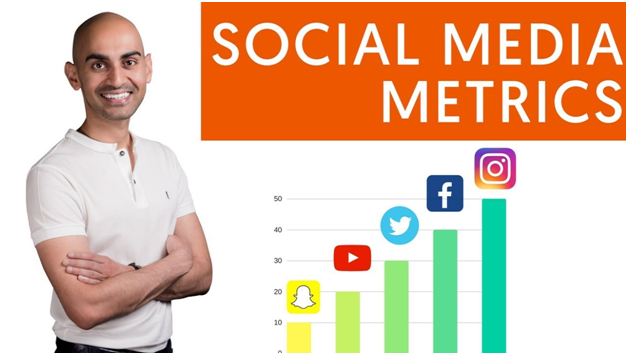A Techie, Blogger & Entrepreneur by heart. Rahul Gupta is founder of IndiBlogHub.com platform and build multiple streams of income via Blogging.
Written by Rahul Gupta » Updated on: July 06th, 2025

Looking for data that can shape social media strategies and promotional campaigns is a difficult task. Well, looking beyond the usual reports for likes and favorites and gauging the success of media promotions is not as simple as counting the likes and the mentions in your post. The true success yardstick lies hidden in the stats which need to be prepared and analyzed.
So, the real certificate for success lies in knowing every
bit of information that can be assimilated from the data uncovered using
essential metrics. It can be anything, right from accessing the number of times
someone has clicked the link or period for which they are active on your
website or app. Also, knowing the nature of the traffic inflow i.e. organic vs.
social media-based can come in handy.

It does take effort to dig deep and get the data out, but then you can require more than just what is available on the surface. We will tell you how to get deeper into the metrics and how to track them.
So, let the data speak, next time around when you prepare the report.

1. Rate of change in new user base
Having new users that follow your brand might seem to be substantial. But that's not always the case, the numbers make sense only when they are calculated over a certain period and then compared with the past dataset. It is the rate of change in users that we are trying to calculate here, it is a change in users divided by the base and then expressed as a percentage.
2. Ascertain the Potential reach
The potential reach mainly refers to new user outreach, primarily, through a chain of existing users. So, for this, you need to analyze your previous posts and see the number of shares for that exact post by the existing user, which is then further shared by new users. A proper analysis of the report saves a lot of your time, and effort in ascertaining the potential reach.
3. Work on engagement variables
The engagement variables which we are referring to here include share, like and comments. But it's not just counting them all and coming with a result. You have to figure out the average rate of engagement. A higher rate indicates that your followers can connect with the post. This is the most important aspect of all which cannot be easily achieved.
4. Count the quick exits
This point essentially deals with monitoring bounce rates.
Let us help with its definition. The bounce rate indicates the percentage of
users who visit the page but within a few seconds exits from the page. Assessing
the bounce rate will help you understand how relevant your post and content
from the point of view of the target audience.

Targeting a large number of the audience under a single
umbrella might not be as useful as reaching each set of individuals under the
same roof. This essentially means that you should collect demographic data like
age, gender, location. The data collected from this metric will offer great
help in promotional campaigns.
Tracking the underlying tone mainly refers to the
sentiment of the user and then attaching a number to it. So, qualitative
sentiments like excellent, good, fair, average and poor are assigned numbers
from 1 to 10.
Social media noise can be jarring and irrelevant at times,
but you need to look for the conversations and opinions around your brand or
even a post. These conversations will be hidden in the form of comments or a
post from the user. It is an important metric to gauge the positive and
negatives views of the users for any new initiatives.
8. Acquaint yourself with CPM
CPM or Cost Per Thousand, where M is for 1,000 ( in Roman
numeral). It refers to the cost incurred for gaining a thousand impressions.
The CPM numbers are a crucial metric to gauge whether your promoted post
reaches the right audience or not. It is calculated by dividing total ad spend
with total impressions, and then multiplying it by 1,000.
9. Track the conversion rate
Conversion rate is calculated to assess the reaction like
download, subscribe or register owe to the promotional side of a post. A higher
conversion rate would indicate the content of the post is inducing a CTA among
the visitors.
10. Monitor the social voice
The share of social voice is also a good indicator of the
campaign effectiveness. Gather data relating to mentions and shares, and then
compare it with competitors. This will help to find where you stand amidst the
crowd.
There's no denying fact that you need to keep the official
page updated. But at the same time
analyzing and finding the right time interval for putting out the post
is also important . This will help to garner the attention of the users, which
otherwise would have been left out.
After all, it is not just about posting in the nick of
time. The post frequency metric should also be taken into consideration. Some
promotional campaigns would require you to put up 5-6 posts in a single, while
others would require just a couple of posts.
Gathering actual reach numbers can be quite handy in
formulating future promotional strategy. By tracking down the actual reach, we
essentially mean the number of visitors who have gone through the post since
its live status. The post reach percentage is calculated by ascertaining the
ratio of the measure of post reach total followers and then multiplying the
ratio by 100.
Brand awareness refers to measures of visibility of the
brand through variables like link shares and mentions but within a certain
period. Gathering data for separate intervals, and then comparing them gives a
clear idea about what's working, and what's not.
Analyzing the CTR will help in understanding the
variability of your offer or post that you have updated with a call to action
link. Click-Through Rate is expressed as a percentage of the ratio of total
link clicks to total impressions.
It might seem a bit bland and contradictory, but gathering
data related to likes and favourites can be an important metric to judge the
promotional campaign. Expressing it as a percentage would be the ideal way to
go about it. You just need to multiply the ratio of total applause and total
follower by 100.
Certainly, one question is the quantitative value of
customer review, but it is a gold mine of information about the product which
consumers want. A proper analysis of the summer review be it good or bad can
have a huge impact on future promotion and marketing strategy.
Benchmarking several engagement variables can be an
important metric for assessing the health of a promotional campaign. For
instance, having a benchmark for the budget set aside in terms of reach in a
particular ethnic group can wonder. You simply cannot cover it all, you need to
rely on standards, and keeping it updated which is the key to stay
relevant.
Have a goal-based metric, for instance, keep set a target number for link clicks, shares, mentions, and likes. The targets must by counting in all the factors like the nature of the product, and the demographics of the target audience. Setting benchmarks should not be confused with setting targets and analyzing them.
To wrap it up, there are various
other social media metrics, and frankly, keeping up with all can be tedious.
So, you need to understand the metrics that work for you in improving ROI by
going deeper into the reports. On a side note, keeping aside all the noises and
influences is the key here.
Author Bio:
Name: BhavikSoni
Bio: BhavikSoni is a Creative Writer at Auto Monkey. We provide an original analysis of the latest
happenings in the social media industry. Connect with Latest Social Media
Trends and News plus tips on Twitter, Facebook and other social tools on the
web.
© 2019-2025 IndiBlogHub.com. All rights reserved. Hosted on DigitalOcean for fast, reliable performance.